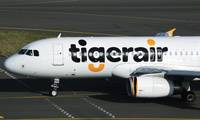News Backgrounder
Overcrowded skies?
Close to sixty low-cost carriers will be flying Asia-Pacific skies by year end. Is the market reaching saturation?
May 1st 2014
Another ten budget carriers will be launched across the Asia-Pacific by year end, adding to the 47 low-cost airlines competing for the region’s bargain hunting present and future travelers. Read More »
 |
| Tigerair has expanded into Taiwan with joint venture partner, China Airlines |
Leading the newcomers into the increasingly crowded Asia-Pacific skies are Tigerair Taiwan, TransAsia Airways’ VJet, AirAsia India, China’s Jiu Yuan, transformed China United Airlines, Thai VietJet and Spring Japan.
Three long-haul budget airlines, Indonesia AirAsia X, Thai AirAsia X and NokScoot also have announced joint ventures in recent months with plans to fly before year-end.
In South Korea, international full service carrier, Asiana Airlines, which controls 46% of domestic LCC, Busan-based Air Busan, said it was considering establishing a second LCC because demand for budget air travel is exceeding present capacity for short and medium-haul travel, especially for destinations in China.
“It would be senseless not to have one more when there is a need,” said Asiana Airlines spokesperson, Lee Hyo-min, last month. The airline plans to lodge an business licence application with South Korea’s aviation regulatory authorities as soon as it finalizes its strategy for the second budget carrier.
Asiana and Korean Air (KAL) are facing increased competition from both regional and local LCCs, with more than 13 budget airlines flying to and within South Korea. To date, KAL does not have plans to expand the network of its LCC, Jin Air, the airline said.
Tigerair Taiwan, the joint venture low-cost carrier (LCC) established by Singapore’s Tigerair (10%) and China Airlines (CAL) at 90%, is planning to launch the US$65 million airline in the final quarter of 2014.
Tigerair Taiwan chief executive, Kwan Yue, said the joint venture partners in the new LCC intended to develop a network that included North Asia destinations in Japan and Korea as well as several cities across Southeast Asia.
Sixty one-year-old Kwan, a retired Singaporean air force officer has held senior positions at Viva Macau, Jetstar Asia and Jetstar Pacific Airlines in Vietnam. He said Tigerair Taiwan will expand by one to two airplanes a year, building its fleet to 12 aircraft in five years.
At an April press conference in Taipei, Kwan said Taiwan’s 23 million population would create sufficient demand for the new airline. The carrier has received more than 10,000 applications for the 180 jobs required by the airline at start-up, he said.
| GE engines to power new AirAsia X airliners Long-haul budget carrier, AirAsia X, has signed a Memorandum of Understanding (MOU) with GE Aviation to power the airline’s new fleet of 25 A330-300 aircraft with the manufacturer’s CF6 engines. The deal, valued at US$1.5 billion, covers options for three more aircraft and GE Aviation’s multi-year onPoint solution service MRO agreement. AirAsia Group CEO, Tony Fernandes, said at the signing, witnessed by U.S. President Obama, that the order will position GE as AirAsia X’s second core engine supplier. “Our fleet has reached sufficient scale to support two engine types, with sufficient spare engine coverage, specialist engineers and technicians and strong on-site service commitment from both engine providers,” Fernandes said. Established seven years ago, AirAsia X is the long-haul subsidiary of the the region’s largest low-cost airline group, the AirAsia Group. AirAsia X flies to 19 destinations in Australia, China, Korea, Japan, Nepal, the Middle East, Sri Lanka and Taiwan, operating a fleet of 16 A330-300s. It has set up a regional long-haul budget hub, AirAsia X Thailand, but has slowed its launch schedule because of continuing political unrest in Thailand, including the nation’s capital, Bangkok. |